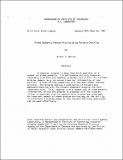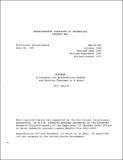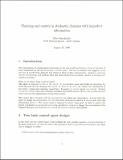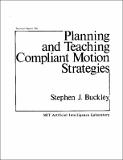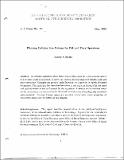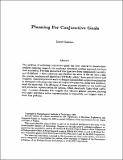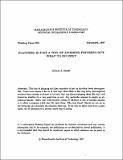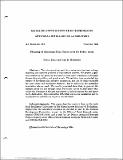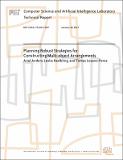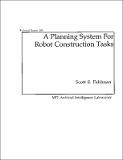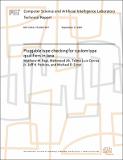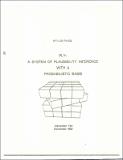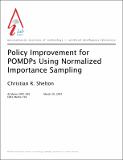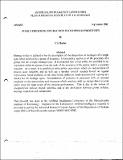Browsing Computer Science and Artificial Intelligence Lab (CSAIL) by Title
Now showing items 2548-2567 of 3804
-
Planar Embedding of Planar Graphs
(1983-02)Planar embedding with minimal area of graphs on an integer grid is an interesting problem in VLSI theory. Valiant [V] gave an algorithm to construct a planar embedding for trees in linear area; he also proved that there ... -
Plane Geometry Theorem Proving Using Forward Chaining
(1974-01-01)A computer program is described which operates on a subset of plane geometry. Its performance not only compares favorably with previous computer programs, but within its limited problem domain (e.g. no curved lines ... -
Planner Implementation Proposal to ARPA 1972-1973
(1971-12-01)The task objective is the generalization and implementation of the full power of the problem solving formalism PLANNER in the next two years. We will show how problem solving knowledge can be effectively incorporated into ... -
PLANNER: A Language for Manipulating Models and Proving Theorems in a Robot
(1970-08-01)PLANNER is a language for proving theorems and manipulating models in a robot. The language is built out of a number of problem-solving primitives together with a hierarchical control structure. Statements can be asserted ... -
PLANNER: A Language for Proving Theorems
(1967-07-01)The following is a description of SCHEMATISE, a proposal for a program that proves very elementary theorems though the use of planning. The method is most easily explained through an example die to Black. -
Planning and Teaching Compliant Motion Strategies
(1987-01-01)This thesis presents a new high level robot programming system. The programming system can be used to construct strategies consisting of compliant motions, in which a moving robot slides along obstacles in its ... -
Planning Collision Free Motions for Pick and Place Operations
(1983-05-01)An efficient algorithm which finds collision free paths for a manipulator with 5 or 6 revolute joints is described. It solves the problem for four degree of freedom pick and place operations. Examples are given of paths ... -
Planning for Conjunctive Goals
(1985-11-01)The problem of achieving conjunctive goals has been central to domain independent planning research; the nonlinear constraint-posting approach has been most successful. Previous planners of this type have been comlicated, ... -
Planning is Just a Way of Avoiding Figuring Out What To Do Next
(MIT Artificial Intelligence Laboratory, 1987-09)The idea of planning and plan execution is just an intuition based decomposition. There is no reason it has to be that way. Most likely in the long term, real empirical evidence from systems we know to be built that way ... -
Planning of Minimum-Time Trajectories for Robot Arms
(1984-11-01)The minimum-time for a robot arm has been a longstanding and unsolved problem of considerable interest. We present a general solution to this problem that involves joint-space tesselation, a dynamic time-scaling ... -
Planning Robust Strategies for Constructing Multi-object Arrangements
(2017-01-30)A crucial challenge in robotics is achieving reliable results in spite of sensing and control uncertainty. A prominent strategy for dealing with uncertainty is to construct a feedback policy, where actions are chosen as a ... -
A Planning System for Robot Construction Tasks
(MIT Artificial Intelligence Laboratory, 1973-05)This paper describes BUILD, a computer program which generates plans for building specified structures out of simple objects such as toy blocks. A powerful heuristic control structure enables BUILD to use a number of ... -
A Planning System for Robot Construction Tasks
(1973-05-01)This paper describes BUILD, a computer program which generates plans for building specified structures out of simple objects such as toy blocks. A powerful heuristic control structure enables BUILD to use a number of ... -
Pluggable type-checking for custom type qualifiers in Java
(2007-09-17)We have created a framework for adding custom type qualifiers to the Javalanguage in a backward-compatible way. The type system designer definesthe qualifiers and creates a compiler plug-in that enforces theirsemantics. ... -
PLY: A System of Plausibility Inference with a Probabilistic Basis
(1982-12)An overview is given of a system of plausibility inference that will be developed for use in planning. This system, to be called PLY, will be specifically designed to work with propositions of the form "when A is true ... -
Policy Improvement for POMDPs Using Normalized Importance Sampling
(2001-03-20)We present a new method for estimating the expected return of a POMDP from experience. The estimator does not assume any knowle ge of the POMDP and allows the experience to be gathered with an arbitrary set of policies. ... -
Policy-Protocol Interaction in Composite Processes
(1982-09-01)Message policy is defined to be the description of the disposition of messages of a single type, when received by a group of processes. Group policy applies to all the processes of a group, but for a single message ... -
POLYBRICK: Adventures in the Domain of Parallelepipeds
(1966-05-01)A collection of programs tries to recognize, which one more successfully than its predecessor, 3-dimensional parallelepipeds (solids limited by 6 planes, parallel two-by-two), using as data 2-dimensional idealized projections. ...


